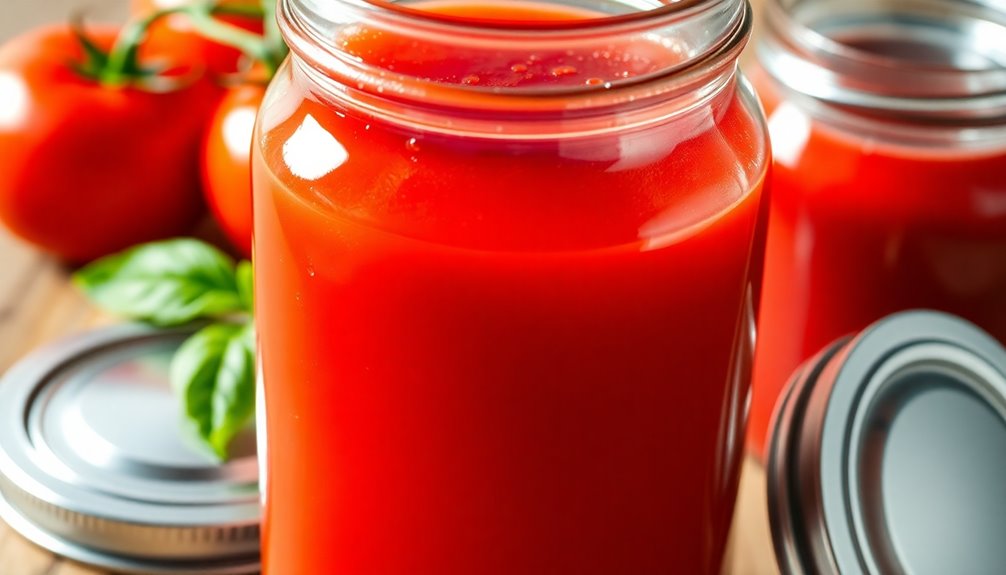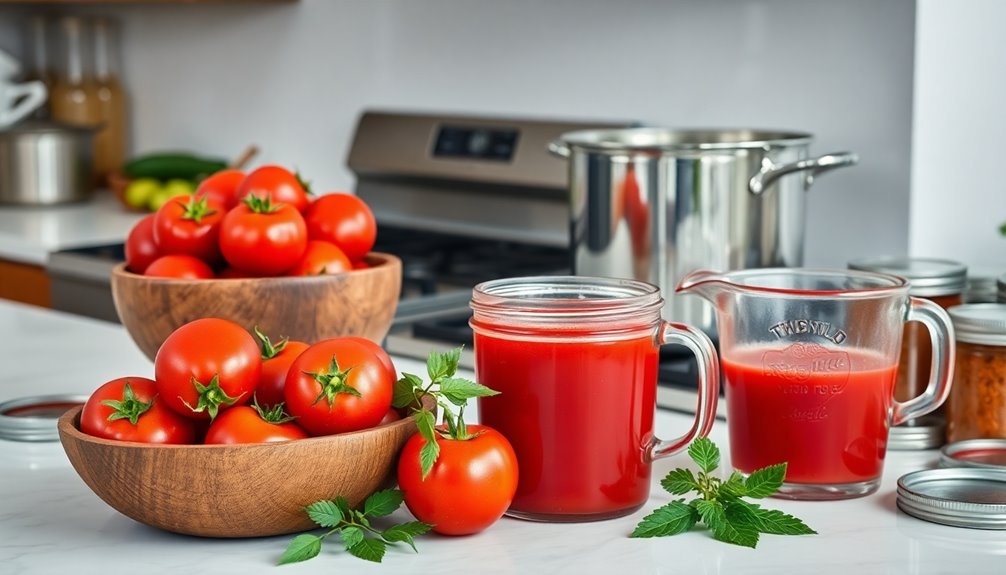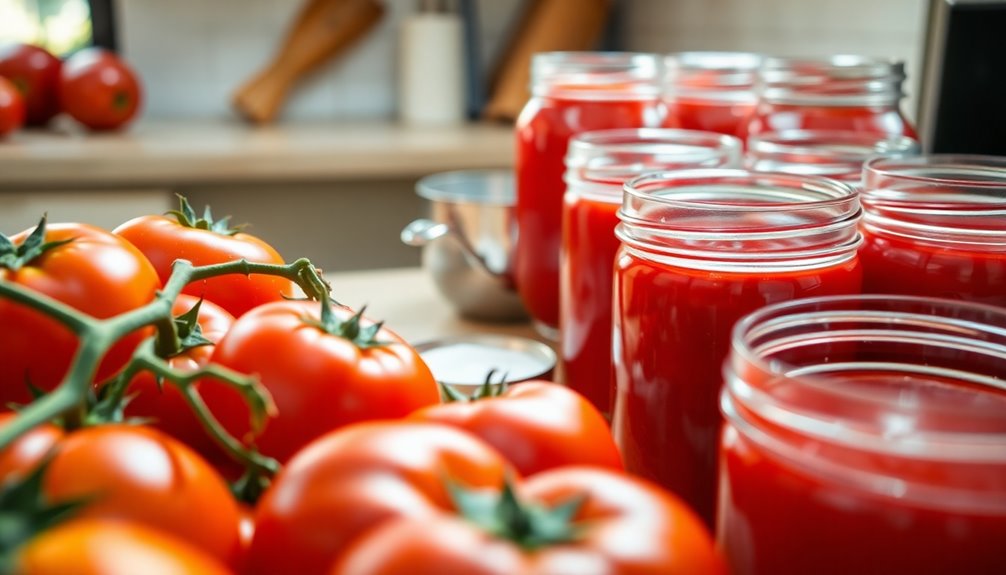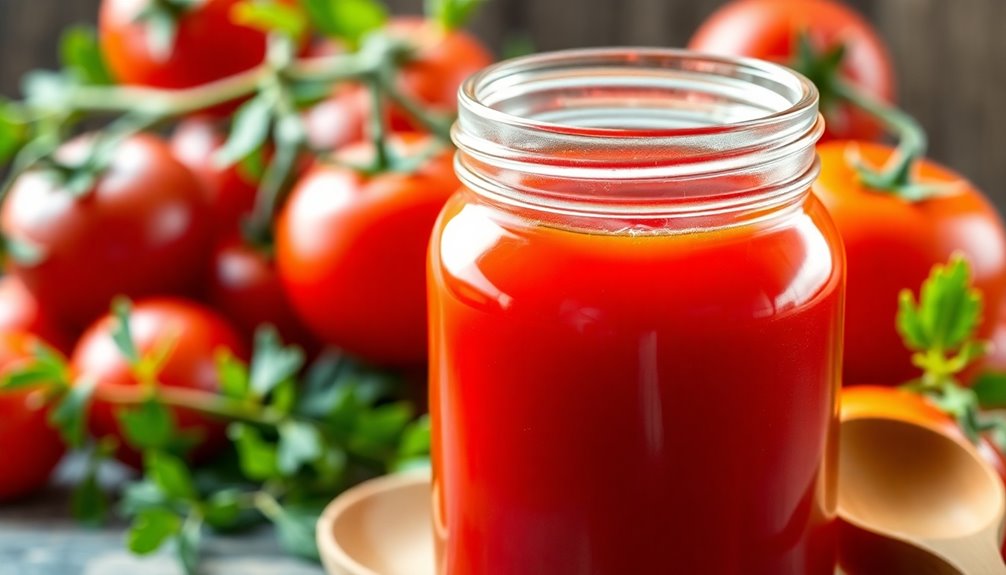To keep your tomato juice from separating when canning, quickly heat your crushed tomatoes to at least 82°C (180°F) to deactivate enzymes. Gradually add uncrushed tomato quarters for even cooking while stirring continuously. Incorporate bottled lemon juice or citric acid to stabilize the mixture. Also, be certain to maintain a boil for five minutes. Proper techniques can make all the difference, so check out more helpful tips to guarantee perfect canning results!
Key Takeaways
- Quickly heat crushed tomatoes to at least 82°C (180°F) to deactivate pectose and prevent juice separation.
- Gradually add uncrushed tomato quarters to maintain texture and limit enzyme activation.
- Incorporate citric acid or bottled lemon juice to stabilize the mixture and improve consistency.
- Stir continuously while cooking to promote even heating and prevent separation.
- Follow safe canning practices, including hot packing and monitoring jar seals for freshness.
Understanding Tomato Juice Separation

When you cut tomatoes, the enzyme pectose activates, causing the juice to separate into pulp and liquid. This natural separation can be frustrating, but understanding the process helps. The natural density differences between the pulp and liquid contribute to this issue, making it essential to control your method.
Quick heating helps deactivate pectose before juicing, so aim for at least 82°C (180°F) for best results. Using a food processor or a food mill can create a smoother texture, reducing separation by ensuring uniformity in your juice.
Additionally, adding citric acid or lemon juice stabilizes the mixture, improving the overall consistency of your canned tomato juice. With these tips, you can enjoy a beautifully blended tomato juice without unwanted separation.
Importance of Proper Heating Techniques

To achieve a smooth, consistent tomato juice without separation, mastering proper heating techniques is crucial. Here are three key steps to follow:
- Quick Heating: Heat crushed tomatoes quickly to at least 82°C (180°F) to deactivate enzyme activity that causes separation.
- Even Cooking: Gradually add uncrushed tomato quarters to the heated mixture while heating and stirring. This guarantees even cooking and limits enzyme activation.
- Immediate Cooking: Don't let crushed tomatoes sit before cooking. Prompt heating prevents enzyme activity and keeps your juice stable.
Effective Preparation Methods for Canning

Effective preparation methods for canning tomato juice are essential in achieving a stable and flavorful product. Start by heating one-sixth of your tomatoes quickly, crushing them to release juice, and then gradually add the rest while keeping the heat high. This helps deactivate the pectinase enzyme at temperatures of at least 82°C (180°F), which prevents separation.
Avoid crushing all the tomatoes beforehand, as this can lead to separation during canning. After cooking, use a food mill or strainer to remove skins and seeds for a smoother texture.
Finally, incorporate acid like bottled lemon juice or citric acid to stabilize your canned tomato juice and guarantee a consistent and delicious result in your home canning endeavors. In addition to stabilizing your canned tomato juice, acidification plays a crucial role in preserving the quality and safety of your home-canned goods. For those interested in harnessing the benefits of citrus, it’s also worth noting that understanding the frozen orange juice shelf life can help you make the most of your fruit storage. By maintaining optimal conditions, you can enjoy the vibrant flavors of your canned items long after they are prepared.
Cooking Process to Maintain Consistency

To keep your tomato juice from separating, start by quickly heating a portion of the tomato quarters in a pot.
As you crush them to release their juices, slowly add the rest of the tomatoes, keeping them intact to prevent over-activating enzymes.
This careful approach sets the stage for a smooth and consistent final product.
Quick Heating Techniques
Although it might seem intimidating, using quick heating techniques can greatly improve the consistency of your canned tomato juice. Here's how to efficiently heat your tomatoes:
- Quickly heat one-sixth of your quartered tomatoes in a pot, crushing them to release their juices. This kickstarts the cooking process.
- Gradually add the remaining quartered tomatoes without crushing them. This helps maintain texture while facilitating rapid heating.
- Maintain a boil for at least five minutes after all tomatoes are in, stirring continuously to prevent burning and guarantee even cooking.
After simmering, don't forget to follow proper canning procedures, including adding necessary acid, to preserve your juice and prevent separation. Your tomato juice will be stable and delicious! Additionally, incorporating fresh tomatoes in your recipe can enhance the flavor profile, making it even more delightful.
Gradual Tomato Addition
While you're preparing your tomato juice, gradually adding the quartered tomatoes is vital for maintaining a smooth consistency.
Start by quickly heating a portion of the tomatoes to deactivate the enzyme that causes separation. As you do this, gradually add the remaining quartered tomatoes to the pot without crushing them. This allows for even heating and helps maintain consistency.
Only crush the tomatoes as you add them to release their juice, ensuring a uniform mixture. Once all the tomatoes are in, bring the mixture to a boil and simmer for 5 minutes. This step is essential for stabilizing your juice before pouring it into the jars, preventing unwanted separation in the final canned product. Additionally, using proper storage techniques will help maintain the quality of your canned goods long-term.
Tips for Safe Canning Practices

Ensuring safe canning practices is essential for preserving the quality and safety of your tomato juice. Follow these tips to keep your canned tomatoes in top shape:
- Use firm, disease-free tomatoes and add 2 tablespoons of bottled lemon juice per quart to maintain safe acidity levels.
- Hot pack your tomatoes by boiling them for 5 minutes before jar filling. This process helps preserve pectin integrity and reduces separation risk.
- Monitor jar seals carefully; listen for the "ping" after cooling, indicating a proper seal. Check for any signs of spoilage, like bubbling or cloudiness, before consuming. Additionally, consider implementing regular review of your canning process to identify and correct any potential issues early on.
Troubleshooting Common Canning Issues

When you can tomatoes, you might notice some floating pieces or liquid loss, which can be frustrating.
Understanding why tomatoes float and how to address liquid loss can help you achieve better results.
Let's explore these common issues and find effective solutions together.
Floating Tomatoes Explained
Floating tomatoes in your jars can be a puzzling issue, but it's usually just the result of air pockets trapped inside. This phenomenon is common with whole tomatoes and doesn't indicate spoilage.
To minimize floating and maintain a better packing, consider these tips:
- Use Regular Mouth Jars: They allow for better packing of whole tomatoes, reducing air pockets.
- Pack Firmly: Verify your tomatoes are packed tightly without crushing them, helping to eliminate spaces.
- Heat Properly: Avoid prolonged heating, which can cause separation of liquid from solids in your canned tomatoes.
Liquid Loss Solutions
To keep your canned tomato juice from separating, addressing liquid loss during the canning process is essential. Here are some solutions to take into account:
| Strategy | Action | Benefit |
|---|---|---|
| Proper Packing | Pack tomatoes tightly in the jar | Reduces air pockets |
| Maintain Boiling Temp | Keep jars in boiling water bath | Prevents liquid loss |
| Add Acid | Use lemon juice or citric acid | Stabilizes mixture |
| Inspect Sealed Jars | Check for siphoning or liquid loss | Guarantees quality retention |
Frequently Asked Questions
How to Keep Tomato Juice From Separating When Canning?
To keep your tomato juice from separating when canning, start by quickly heating and crushing part of the tomatoes.
Gradually add the rest of the quartered tomatoes, ensuring they reach at least 82°C (180°F) to deactivate the enzyme causing separation.
Avoid letting crushed tomatoes sit before cooking.
Adding bottled lemon juice or citric acid can help stabilize the mixture.
Finally, boil the tomatoes for five minutes before filling jars for the best results.
How Do You Make Tomato Juice That Doesn't Separate?
To make tomato juice that doesn't separate, start by quickly heating a portion of your cut tomatoes and crushing them to release their juices.
Gradually add the rest of the tomatoes while maintaining a boiling temperature of at least 82°C (180°F) for five minutes.
Incorporate bottled lemon juice or citric acid to stabilize the mixture.
Finally, use a food mill or strainer to guarantee a smooth texture, minimizing separation in your final product.
How to Prevent Tomato Sauce From Separating?
To prevent your tomato sauce from separating, heat a portion of the quartered tomatoes quickly in a pot and crush them to release their juices.
Keep the heat high, at least 180°F, and gradually add the remaining tomatoes without crushing them.
Don't let crushed tomatoes sit before cooking, and consider adding citric acid or bottled lemon juice for acidity.
Simmer the sauce for an extra five minutes after all tomatoes are added for better consistency.
Why Does Tomato Sauce Separate When Canning?
Tomato sauce separates during canning mainly because of the enzyme Pectose, which activates when you cut or crush tomatoes.
This enzyme breaks down the pectin that holds the tomato solids together. If you let crushed tomatoes sit before cooking, it only worsens the separation.
To minimize this, heat your tomatoes quickly and keep them at the right temperature while adding more, ensuring a smoother sauce in your final product.
Conclusion
By mastering these techniques, you can keep your tomato juice as smooth as silk, ensuring it's both delicious and visually appealing. Remember, the key lies in proper heating and preparation; a little care goes a long way in canning. Don't let separation steal your joy—stay vigilant, and you'll enjoy the fruits of your labor for months to come. With these tips in hand, you're ready to can like a pro and savor every sip!
Susannah expertise lies in researching and compiling evidence-based content on juicing, nutrition, and overall health. She is committed to ensuring that The Juicery World offers accurate, up-to-date, and trustworthy information to empower readers to take control of their health. Susannah’s goal is to inspire individuals to embrace juicing as a way to nourish their bodies and live their best lives.











